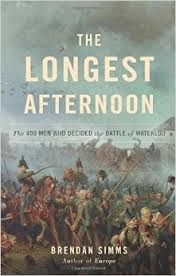The Longest Afternoon: The 400 Men Who Decided the Battle of Waterloo
- By Brendan Simms
- Basic Books
- 208 pp.
- Reviewed by Dane Kennedy
- March 6, 2015
This tight, vivid account brings the reader into the heart of the epic conflict.

“Waterloo” is one of those words that carries a special charge in the Western imagination. A hitherto obscure village in Belgium, it became the site of one of the most infamous battles in history, a climactic clash between an army under the command of the Duke of Wellington and a resurgent French force led by the relentless Napoleon Bonaparte.
On June 18, 1815, Napoleon’s bid to reclaim his empire came to a crashing end at Waterloo and, with it, the rest of Europe escaped French domination.
There are plenty of books about the Battle of Waterloo, but most either cast it as a personal duel between Wellington and Napoleon or characterize it as an impersonal series of strategic and tactical decisions played out on the battlefield. In The Longest Afternoon, Brendan Simms focuses instead on a group of individuals from a single battalion who stood at the center of the conflict and whose actions, according to the book’s subtitle, “decided the battle of Waterloo.”
The Second Light Battalion of the King’s German Legion had its origins in Hanover, the German state whose ruler, known as the Elector, also happened to be George III, king of Great Britain. The battalion was composed mainly of men from Hanover and other German states, though it was part of the British army. It had some British soldiers in its ranks and was staffed mainly by British officers, with English the language of command.
Various members of the battalion wrote diaries, memoirs, and other accounts of their actions at Waterloo, and Simms makes skillful use of this rich body of material to tell the story of the battle as the troops experienced it. The result is a vivid recounting of their costly struggle to defend a farmhouse known as La Haye Sainte, which stood at the eye of the storm.
Simms credits the battalion with delaying the French advance until a Prussian army arrived to reinforce Wellington, leading to Napoleon’s defeat. The battalion paid a heavy price for its efforts, suffering 168 casualties (out of just under 400 men).
Simms asks why the members of this force fought with such fierce determination, displaying exceptional courage in resisting wave after wave of French assaults. Since many of them were not Hanoverians, and some weren’t even German, he rejects the view that they were motivated by a sense of comradeship derived from common origins and identity. He also finds no evidence that they held their positions out of fear they would be punished as deserters.
Instead, he argues they were inspired by patriotic loyalty to king and country — though that begs the question of which country, Britain or Hanover or some other German state — and, more persuasively, by a visceral hatred of French imperialism, which had wreaked havoc on the nation’s European neighbors for more than a dozen years.
In an apt and revealing observation, Simms compares the members of the battalion to the Free French forces that fought under the command of Charles de Gaulle against Nazi Germany during World War II.
Simms’ account of the struggle over La Haye Sainte is taut and briskly told. It follows events both on a macro level, tracking the movements of the military units involved in the action, and a micro level, detailing the experiences of specific soldiers during the chaos of combat.
Fans of military history will likely welcome the attention given to a hitherto neglected aspect of Waterloo, though they might wish it had more to say about the relationship between this engagement and the overall course of the battle.
The dramatic pace of Simms’ narrative is sure to appeal to other readers, though they might regret the absence of commentary on the battle’s broader historical significance. The brevity of the book (less than 130 pages of text, with large type and generous margins) makes for a quick read, but a circumscribed one.
Anyone who wants to learn how the struggle to control Europe led to the Battle of Waterloo or why its outcome proved so important to Europe’s future will have to look elsewhere for answers. This book is intended for those who are already familiar with the bigger story or who simply want a gripping and original account of men in battle.
Dane Kennedy is the Elmer Louis Kayser Professor of History and International Affairs at George Washington University, where he teaches British imperial history. His most recent book is The Last Blank Spaces: Exploring Africa and Australia.

